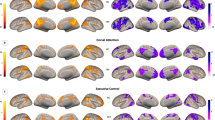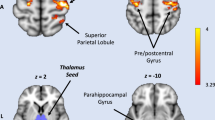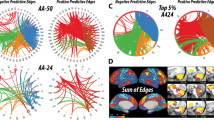Abstract
N-methyl-D-aspartate glutamate receptor (NMDA-R) antagonists produce schizophrenia-like positive and negative symptoms in healthy human subjects. Preclinical research suggests that NMDA-R antagonists interfere with the function of gamma-aminobutyric acid (GABA) neurons and alter the brain oscillations. These changes have been hypothesized to contribute to psychosis. In this investigation, we evaluated the hypothesis that the NMDA-R antagonist ketamine produces alterations in cortical functional connectivity during rest that are related to symptoms. We administered ketamine to a primary sample of 22 subjects and to an additional, partially overlapping, sample of 12 subjects. Symptoms before and after the experimental session were rated with the Positive and Negative Syndrome Scale (PANSS). In the primary sample, functional connectivity was measured via functional magnetic resonance imaging almost immediately after infusion began. In the additional sample, this assessment was repeated after 45 min of continuous ketamine infusion. Global, enhanced functional connectivity was observed at both timepoints, and this hyperconnectivity was related to symptoms in a region-specific manner. This study supports the hypothesis that pathological increases in resting brain functional connectivity contribute to the emergence of positive and negative symptoms associated with schizophrenia.
This is a preview of subscription content, access via your institution
Access options
Subscribe to this journal
Receive 12 print issues and online access
$259.00 per year
only $21.58 per issue
Buy this article
- Purchase on Springer Link
- Instant access to full article PDF
Prices may be subject to local taxes which are calculated during checkout




Similar content being viewed by others
References
Krystal J, Abi-Dargham A, Laruelle M, Moghaddam B . Pharmacologic model psychoses. In: Charney D, Nestler E, Bunney B, (eds) Neurobiology of Mental Illness. Oxford University Press: New York pp 214–224 1999.
Krystal JH, Karper LP, Seibyl JP, Freeman GK, Delaney R, Bremner JD et al. Subanesthetic effects of the noncompetitive NMDA antagonist, ketamine, in humans: psychotomimetic, perceptual, cognitive, and neuroendocrine responses. Arch Gen Psychiatry 1994; 51: 199–214.
Domino E, ChodoffF P, Corsenn G . Pharmacologic effects of CI-581, a new dissociative anesthetic, in man. Clin Pharmacol Ther 1965; 6: 279–291.
Cohen B, Rosenbaum G, Luby E, Gottlieb J . Comparison of phencyclidine hydrochloride (sernyl) with other drugs: simulation of schizophrenic performance with phencyclidine hydrochloride (sernyl), lysergic acid diethylamide (lsd-25), and amobarbital (amytal) sodium; ii. symbolic and sequential thinking. Arch Gen Psychiatry 1962; 6: 395–401.
Rosenbaum G, Cohen B, Luby E, Gottlieb J, Yelen D . Comparison of sernyl with other drugs: simulation of schizophrenic performance with sernyl, lsd-25, and amobarbital (amytal) sodium; i. attention, motor function, and proprioception. Arch Gen Psychiatry 1959; 1: 651–656.
Krystal JH, Perry EB, Gueorguieva R, Belger A, Madonick SH, Abi-Dargham A et al. Comparative and interactive human psychopharmacologic effects of ketamine and amphetamine: implications for glutamatergic and dopaminergic model psychoses and cognitive function. Arch Gen Psychiatry 2005; 62: 985–994.
Volenweider F . Advances and pathophysiological model of hallucinogenic drug action in humans: a preamble to schizophrenia research. Pharmacopsychiatry 1998; 31 (Supplement): 92–103.
Stone J, Erlandsson K, Arstad E, Squassante L, Teneggi V, Bressan R et al. Relationship between ketamine-induced psychotic symptoms and NMDA receptor occupancy: a [(123)I]CNS-1261 SPET study. Psychopharmacology (Berl) 2008; 197: 401–408.
Holcomb H, Lahti A, Medoff D, Cullen T, Tamminga C . Effects of noncompetitive NMDA receptor blockade on anterior cingulate cerebral blood flow in volunteers with schizophrenia. Neuropsychopharmacology 2005; 30: 2275–2282.
Holcomb HH, Lahti AC, Medoff DR, Weiler M, Tamminga CA . Sequential regional cerebral blood flow brain scans using PET with H2(15)O demonstrate ketamine actions in CNS dynamically. Neuropsychopharmacology 2001; 25: 165–172.
Lahti AC, Holcomb HH, Medoff DR, Tamminga CA . Ketamine activates psychosis and alters limbic blood flow in schizophrenia. Neuroreport 1995; 6: 869–872.
Vollenweider F, Leenders K, Scharfetter C, Antonini A, Maguire P, Missimer J et al. Metabolic hyperfrontality and psychopathology in the ketamine model of psychosis using positron emission tomography (PET) and [18F]fluorodeoxyglucose (FDG). Eur Neuropsychopharmacol 1997; 7: 9–24.
Breier A, Malhotra A, Pinals D, Weisenfeld N, Pickar D . Association of ketamine-induced psychosis with focal activation of the prefrontal cortex in healthy volunteers. Am J Psychiatry 1997; 154: 805–811.
Stone JM, Dietrich C, Edden R, Mehta MA, De Simoni S, Reed LJ et al. Ketamine effects on brain GABA and glutamate levels with 1H-MRS: relationship to ketamine-induced psychopathology. Mol Psychiatry 2012; 17: 664–665.
Grunze HC, Rainnie DG, Hasselmo ME, Barkai E, Hearn EF, McCarley RW et al. NMDA-dependent modulation of CA1 local circuit inhibition. J Neurosci 1996; 16: 2034–2043.
Maccaferri G, Dingledine R . Control of feedforward dendritic inhibition by NMDA receptor-dependent spike timing in hippocampal interneurons. J Neurosci 2002; 22: 5462–5472.
Jackson ME, Homayoun H, Moghaddam B . NMDA receptor hypofunction produces concommitant firing rate potentiation and burst activity reduction in the prefrontal cortex. Neuroscience 2004; 101: 8467–8472.
Homayoun H, Moghaddam B . NMDA receptor hypofunction produces opposite effects on prefrontal cortex interneurons and pyramidal neurons. The Journal of Neuroscience 2007; 27: 11496–11500.
Yonezawa Y, Kuroki T, Kawahara T, Tashiro N, Uchimura H . Involvement of γ-aminobutyric acid neurotransmission in phencyclidine-induced dopamine release in the medial prefrontal cortex. Eur J Pharmacol 1998; 341: 45–56.
Moghaddam B, Adams B, Verma A, Daly D . Activation of glutamatergic neurotransmission by ketamine: a novel step in the pathway from NMDA receptor blockade to dopaminergic and cognitive disruptions associated with the prefrontal cortex. The Journal of Neuroscience 1997; 17: 2921–2927.
Amitai N, Kuczenski R, Behrens MM, Markou A . Repeated phencyclidine administration alters glutamate release and decreases GABA markers in the prefrontal cortex of rats. Neuropharmacology 2012; 62: 1422–1431.
Castner SA, Arriza JL, Roberts JC, Mrzljak L, Christian EP, Williams GV . Reversal of ketamine-induced working memory impairments by the GABAA[alpha]2/3 Agonist TPA023. Biol Psychiatry 2010; 67: 998–1001.
Homayoun H, Jackson M, Moghaddam B . Activation of metabotropic glutamate 2/3 receptors reverses the effects of NMDA receptor hypofunction on prefrontal cortex unit activity in awake rats. J Neurophysiol 2005; 93: 1989–2001.
Moghaddam B, Adams BW . Reversal of phencyclidine effects by a group II metabotropic glutamate receptor agonist in rats. Science 1998; 281: 1349–1352.
Krystal JH, Abi-Saab W, Perry E, D’Souza DC, Liu N, Gueorguieva R et al. Preliminary evidence of attenuation of the disruptive effects of the NMDA glutamate receptor antagonist, ketamine, on working memory by pretreatment with the group II metabotropic glutamate receptor agonist, LY354740, in healthy human subjects. Psychopharmacology (Berl) 2005; 179: 303–309.
Pinault D . N-Methyl d-Aspartate receptor antagonists ketamine and MK-801 induce wake-related aberrant [gamma] oscillations in the rat neocortex. Biol Psychiatry 2008; 63: 730–735.
Wood J, Kim Y, Moghaddam B . Disruption of prefrontal cortex large scale neuronal activity by different classes of psychotomimetic drugs. The Journal of Neuroscience 2012; 32: 3022–3031.
Lovett-Barron M, Turi GF, Kaifosh P, Lee PH, Bolze F, Sun X-H et al. Regulation of neuronal input transformations by tunable dendritic inhibition. Nat Neurosci 2012; 15: 423–430.
Royer S, Zemelman B, Losonczy A, Kim J, Chance F, Magee J et al. Control of timing, rate and bursts of hippocampal place cells by dendritic and somatic inhibition. Nat Neurosci 2012; 15: 769–775.
Cole MW, Pathak S, Schneider W . Identifying the brain's most globally connected regions. NeuroImage 2010; 49: 3132–3148.
Cole MW, Yarkoni T, Repovš G, Anticevic A, Braver TS . Global connectivity of prefrontal cortex predicts cognitive control and intelligence. The Journal of Neuroscience 2012; 32: 8988–8999.
Cole MW, Anticevic A, Repovs G, Barch D . Variable global dysconnectivity and individual differences in schizophrenia. Biol Psychiatry 2011; 70: 43–50.
First M, Spitzer R, Gibbon M, Williams J . Structured Clinical Interview for DSM-IV Axis I Disorders, Research Version, Non-Patient Edition. Biometrics Research, New York State Psychiatric Institute: New York, 2002.
Eckblad MJ, Chapman LJ, Chapman JP, Mishlove M The revised social anhedonia scale. unpublished.
Chapman LJ, Chapman JP, Raulin ML . Body image aberration in schizophrenia. J Abnorm Psychol 1978; 87: 399–407.
Eckblad ML, Chapman LJ, Chapman JP . Magical ideation as an indicator of schizotypy. J Consult Clin Psychol 1983; 51: 215–222.
Janca A, Bucholz K, Janca I . Family History Assessment Module Version 5. Washington University School of Medicine: St Louis, 1997.
Kaye S, Opler L, Fiszbein A . Positive and Negative Syndrome Scale. Multi-Health Systems, Inc.: Toronto, Ontario, 1986.
Krystal JH, Karper LP, Bennett A, D'Souza DC, Abi Dargham A, Morrissey K et al. Interactive effects of subanesthetic ketamine and subhypnotic lorazepam in humans. Psychopharmacology (Berl) 1998; 135: 213–229.
Cox RW . AFNI: software for analysis and visualization of functional magnetic resonance neuroimages. Comput Biomed Res 1996; 29: 162–173.
Smith S . Fast robust automated brain extraction. Hum Brain Mapp 2002; 17: 143–155.
Jenkinson M, Bannister P, Brandy M, Smith S . Improved optimization for the robust and accurate linear registration and motion correction of brain images. Neuroimage 2002; 17: 825–841.
Woolrich M, Ripley B, Brady M, Smith S . Temporal autocorrelation in univariate linear modeling of FMRI data. NeuroImage 2001; 14: 1370–1386.
Bell M, Lysaker P, Beam-Goulet J, Milstein R, Lindemayer J . Five-component model of schizophrenia: assessing the factorial invariance of the positive and negative syndrome scale. Psychiat Res 1994; 52: 295–303.
Bryson G, Bell M, Greig T, Kaplan E . Internal consistency, temporal stability and neuropsychological correlates of three cognitive components of the Positive and Negative Syndrome Scale (PANSS). Schizophr Res 1999; 38: 27–35.
Peralta V, Cuesta MJ . Psychometric properties of the Positive and Negative Syndrome Scale (PANSS) in schizophrenia. Psychiat Res 1994; 53: 31–40.
Lindenmayer JP, Bernstein Hyman R, Grochowski S . Five-factor model of schizophrenia. Initial validation. J Nerv Ment Dis 1994; 182: 631–638.
Dollfus S, Petit M, Lesieur P, Mendard JF . Principal-component analysis of PANSS and SANS-SAPS global ratings in schizophrenia patients. Eur Psychiatry 1991; 6: 251–259.
Hakami T, Jones N, Tolmacheva E, Gaudias J, Chaumont J, Salzberg M et al. NMDA receptor hypofunction leads to generalized and persistent aberrant gamma oscillations independent of hyperlocomotion and the state of consciousness. PLoS ONE 2009; 4: e6755–e6755.
Ehrlichman RS, Gandal MJ, Maxwell CR, Lazarewicz MT, Finkel LH, Contreras D et al. N-methyl-d-aspartic acid receptor antagonist-induced frequency oscillations in mice recreate pattern of electrophysiological deficits in schizophrenia. Neuroscience 2009; 158: 705–712.
Corlett PR, Taylor JR, Wang XJ, Fletcher PC, Krystal JH . Toward a neurobiology of delusions. Prog Neurobiol 2010; 92: 345–369.
Yoon JH, Rokem AS, Silver MA, Minzenberg MJ, Ursu S, Ragland JD et al. Diminished orientation-specific surround suppression of visual processing in schizophrenia. Schizophr Bull 2009; 35: 1078–1084.
Carlsson A, Hansson LO, Waters N, Carlsson ML . Neurotransmitter aberrations in schizophrenia: new perspectives and therapeutic implications. Life Sci 1997; 61: 75–94.
Hoffman RE, Hampson M . Functional connectivity studies of patients with auditory verbal hallucinations. Frontiers in Human Neuroscience 2012; 6: 6.
Hoffman RE, Hampson M, Wu K, Anderson AW, Gore JC, Buchanan RJ et al. Probing the pathophysiology of auditory/verbal hallucinations by combining functional magnetic resonance imaging and transcranial magnetic stimulation. Cerebral Cortex 2007; 17: 2733–2743.
Haber SN, Calzavara R . The cortico-basal ganglia integrative network: the role of the thalamus. Brain Res Bull 2009; 78: 69–74.
Calzavara R, Mailly P, Haber S . Relationship between the corticostriatal terminals from areas 9 and 46, and those from area 8A, dorsal and rostral premotor cortex and area 24c: an anatomical substrate for cognition to action. Eur J Neurosci 2007; 26: 2005–2024.
Haber S . The primate basal ganglia: parallel and integrative networks. J Chem Neuroanat 2003; 26: 317–330.
Oye N, Hustvelt O, Moberg ER, Pausen O, Skoglund LS . The chiral forms of ketamine as probed for NMDA receptor function in humans. In: Kameyama T, Nabeshima T, Domino E, (eds) NMDA Receptor Related Agents: Biochemistry, Pharmacology, and Behavior vol.: 381–389 NPP Books: Ann Arbor: MI, 1991.
Smith DJ, Westfall DP, Adams JD . Ketamine interacts with opiate receptors as an agonist. Anesthesiology 1980; 53: S5.
Cohen ML, Chan SL, Bhargava HN, Trevor AJ . Inhibition of mammalian brain acetylcholinesterase by ketamine. Biochem Pharmacol 1974; 23: 1647–1652.
Krystal JH, D’Souza DC, Karper LP, Bennett A, Abi-Dargham A, Abi-Saab D et al. Interactive effects of subanesthetic ketamine and haloperidol in healthy humans. Psychopharmacology (Berl) 1999; 145: 193–204.
Krystal JH, Madonick S, Perry E, Gueorguieva R, Brush L, Wray Y et al. Potentiation of low dose ketamine effects by naltrexone: potential implications for the pharmacotherapy of alcoholism. Neuropsychopharmacology 2006; 31: 1793–1800.
Acknowledgements
We wish to thank the following individuals: Drs Michelle Hampson and Pawel Skudlarski provided many interesting discussions of connectivity, in general, and of this project, specifically. Cheryl Lacadie helped informally with a number of image processing and software issues. Kathleen Maloney, Julie Holub, Cara Cordeaux and Nikia McFadden served as research assistants. Nursing care was provided by the Yale Center for Clinical Investigation and the Biostudies Unit, Neurobiological Diagnostic Studies Unit of the VA CT Healthcare System, West Haven, CT. MRI technologists Hedy Sarofin and Karen A Martin supplied expert assistance for this complex MRI protocol.
Sources of financial support include: Yale-Pfizer Alliance (NRD); National Alliance for Research on Schizophrenia and Depression-Distinguished Investigator Award (JHK) and Young Investigator Award (ZB); Conte Center Calcium Signaling and Prefrontal Deficits in Schizophrenia, NIMH; National Center Post Traumatic Stress Disorder, Clinical Neurosciences Division, West Haven, CT, National Institute on Alcohol Abuse and Alcoholism, 2P50 AA 012870; U.S. Department of Veterans Affairs Alcohol Research Center; NIH National Center for Research Resources CTSA Grant Number UL1 RR024139; NIH Grant Number K23-MH077914, and the State of CT Department of Mental Health and Addiction Services.
Author information
Authors and Affiliations
Corresponding author
Ethics declarations
Competing interests
JHK consults for several pharmaceutical and biotechnology companies with compensation less than $10 000 per year. All other authors declare that they have no conflict of interest.
Rights and permissions
About this article
Cite this article
Driesen, N., McCarthy, G., Bhagwagar, Z. et al. Relationship of resting brain hyperconnectivity and schizophrenia-like symptoms produced by the NMDA receptor antagonist ketamine in humans. Mol Psychiatry 18, 1199–1204 (2013). https://doi.org/10.1038/mp.2012.194
Received:
Revised:
Accepted:
Published:
Issue Date:
DOI: https://doi.org/10.1038/mp.2012.194
Keywords
This article is cited by
-
Higher-order functional brain networks and anterior cingulate glutamate + glutamine (Glx) in antipsychotic-naïve first episode psychosis patients
Translational Psychiatry (2024)
-
Vasotocin receptor gene genotypes moderate the relationship between cortical thickness and sensory processing
Translational Psychiatry (2023)
-
Network biomarkers in recovered psychosis patients who discontinued antipsychotics
Molecular Psychiatry (2023)
-
Measuring acute effects of subanesthetic ketamine on cerebrovascular hemodynamics in humans using TD-fNIRS
Scientific Reports (2023)
-
A three-dimensional model of neural activity and phenomenal-behavioral patterns
Molecular Psychiatry (2023)



